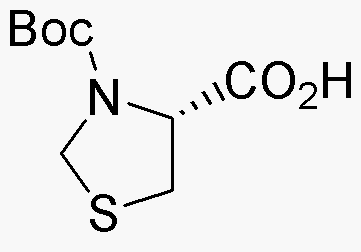Boc-L-thiaproline is widely utilized in research focused on:
- Peptide Synthesis: This compound serves as a valuable building block in the synthesis of peptides, particularly in the development of cyclic peptides that can enhance biological activity.
- Drug Development: It plays a crucial role in medicinal chemistry, where it is used to design and synthesize novel drugs, especially those targeting specific receptors or enzymes.
- Bioconjugation: Researchers leverage Boc-L-thiaproline for bioconjugation processes, allowing for the attachment of biomolecules to therapeutic agents, improving their efficacy and targeting capabilities.
- Protein Engineering: Its unique structure aids in the modification of proteins, enabling scientists to create proteins with enhanced stability and functionality for various applications in biotechnology.
- Research in Neuroscience: The compound is explored for its potential applications in neuroscience, particularly in studying the effects of modified peptides on neurological pathways and disorders.
Informations générales
Propriétés
Sécurité et réglementation
Applications
Boc-L-thiaproline is widely utilized in research focused on:
- Peptide Synthesis: This compound serves as a valuable building block in the synthesis of peptides, particularly in the development of cyclic peptides that can enhance biological activity.
- Drug Development: It plays a crucial role in medicinal chemistry, where it is used to design and synthesize novel drugs, especially those targeting specific receptors or enzymes.
- Bioconjugation: Researchers leverage Boc-L-thiaproline for bioconjugation processes, allowing for the attachment of biomolecules to therapeutic agents, improving their efficacy and targeting capabilities.
- Protein Engineering: Its unique structure aids in the modification of proteins, enabling scientists to create proteins with enhanced stability and functionality for various applications in biotechnology.
- Research in Neuroscience: The compound is explored for its potential applications in neuroscience, particularly in studying the effects of modified peptides on neurological pathways and disorders.
Documents
Fiches de données de sécurité (FDS)
La FDS fournit des informations de sécurité complètes sur la manipulation, le stockage et l’élimination du produit.
Spécifications du produit (PS)
Le PS fournit une description complète des propriétés du produit, notamment sa composition chimique, son état physique, sa pureté et les exigences de stockage. Il détaille également les plages de qualité acceptables et les applications prévues du produit.
Certificats d'analyse (COA)
Recherchez des certificats d'analyse (COA) en saisissant le numéro de lot du produit. Les numéros de lot et de lot se trouvent sur l'étiquette d'un produit, après les mots « Lot » ou « Lot de fabrication ».
Numéro de catalogue
Numéro de lot/série
Certificats d'origine (COO)
Ce certificat d'exploitation confirme le pays dans lequel le produit a été fabriqué, et détaille également les matériaux et composants utilisés et s'il est issu de sources naturelles, synthétiques ou autres sources spécifiques. Ce certificat peut être requis pour les douanes, le commerce et la conformité réglementaire.
Numéro de catalogue
Numéro de lot/série
Fiches de données de sécurité (FDS)
La FDS fournit des informations de sécurité complètes sur la manipulation, le stockage et l’élimination du produit.
DownloadSpécifications du produit (PS)
Le PS fournit une description complète des propriétés du produit, notamment sa composition chimique, son état physique, sa pureté et les exigences de stockage. Il détaille également les plages de qualité acceptables et les applications prévues du produit.
DownloadCertificats d'analyse (COA)
Recherchez des certificats d'analyse (COA) en saisissant le numéro de lot du produit. Les numéros de lot et de lot se trouvent sur l'étiquette d'un produit, après les mots « Lot » ou « Lot de fabrication ».
Numéro de catalogue
Numéro de lot/série
Certificats d'origine (COO)
Ce certificat d'exploitation confirme le pays dans lequel le produit a été fabriqué, et détaille également les matériaux et composants utilisés et s'il est issu de sources naturelles, synthétiques ou autres sources spécifiques. Ce certificat peut être requis pour les douanes, le commerce et la conformité réglementaire.


